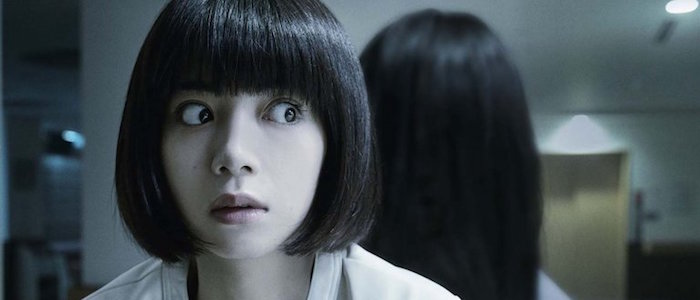Ringu director Hideo Nakata returns from whence he came with Sadako, another J-Horror offshoot inspired by Kôji Suzuki’s malevolent novels. Audiences more familiar with Gore Verbinski’s The Ring remake should understand this foreign import favors storytelling over paralyzing scares – or, at least attempts to highlight scripted intrigue. That’s not to say previous Ringu-adjacent titles care only about jumps, but Sadako barely musters enough fear to meet Shudder’s Sadako vs. Kayako crossover. Which, if you’ve seen the heavyweight rumble, isn’t a particularly high bar to vault over.
Elaiza Ikeda stars as psychologist Mayu Akikawa, a hospital employee whose latest patient is an abandoned child (Himeka Himejima). Elsewhere, Mayu’s YouTube (equivalent) “celebrity” brother Kazuma (Hiroya Shimizu) is off embarrassing himself for internet clicks. As Mayu observes the child, information about her upbringing suggests ties to a name best not uttered. At the same time, Kazuma seeks subscriber-base fame by exploring a burned apartment building (lil’ mystery patient’s former home) currently condemned because of its “haunted” past. It’s not soon after that Kazuma goes missing, Mayu finds a strange clip spliced into Kazuma’s videos, and the legend of “Sadako” begins anew.
Writer Noriaki Sugihara reimagines Sadako’s outreach through live streaming and viral video terms. We’ve evolved from damned physical media to tainted online clips, much like in 2017’s Rings. Sadako opens the door to prankster personalities spreading subliminal curses through their latest “pick up girls in a mini-truck” uploads (actual video we watch), teasing how Sadako can continue to claim souls. It’s a necessary reinvention in terms of modernization, but also only half fleshed-out deciphering when Sadako appears and in whose videos. Kazuma awakens the beast by infiltrating soiled grounds, but why does Japan’s next hopeful Logan Paul become afflicted? As we learn, that’s nary most important.
Nakata’s vision for Sadako is that of an unsettled drama favoring talisman mysticism over in-your-face screams. Gone is Sadako’s well, now an island cavern system where children were once swallowed by tidewaters as a form of sacrifice. There’s more to learn about a small psychic child whose mother once tried to burn their apartment down thinking her daughter was Sadako incarnate – who was also saved by Sadako? But then is followed and chased by Sadako? Mayu’s motivation – powered by her loneliness as an orphan – is always to protect the rescued child under her watch. It’s just that Sugihara’s smashup of Kazuma’s disappearance and the child’s relationship to Sadako confuses already flimsy trajectories. Two subplots fighting for dominance, loosely wrapped together with ties that struggle to bind.
While Mayu freeze-frames Kazuma’s posted content and analyzes new black-and-white clips incorporated by Sadako, it’s hard to ignore how the chilling imagery that once defined Ringu is missing. Even Slender Man features scarier, more invasive imagery when playing its “infectious” recording. Save for one throwback instance where Sadako crawls through a digital television barrier towards one cowering victim, Sadako’s hair-covered presence is never maximized. A ghostly-pale hand may grab someone’s shoulder, Sadako’s bones crackling as she crawls on all fours, but there’s a disappointing sense of devolved thrills throughout Nakata’s latest. Kazuma’s shaky-cam gasps, Sadako’s lurking within reflections, waterfront lair submerging – all such downplayed traumatization.
Benefitting the slower and more casual tone of Sadako is a score that reminds of Italian classics and instrumentally inclined orchestral efforts. Original scoring teases mystery over horror, which – in this case – is a vital necessity. Mundane detective work finds an alluring backdrop in the form of musical accompaniment, building atmosphere through what we hear more than the visuals Nakata’s team puts on screen. Sound design benefits Sadako and livens scenes where a lack of villainy might become more noticeable otherwise.
For the record, I’m not coming down on Sadako for being an investigative ghost story and less a shocking nightmare. It’s more how the pieces fit – or, in this case, fail to interlock – as we’re left scratching our heads over what Sadako’s placement in this revamped world even means. Attempts at backstory only lead to more blurry beginnings, retreading the same Ringu blueprints but without freakish intensity, provoked squeals, or signature devastation that once dominated international markets. Sweeter sentiments fail Sadako’s latest uprising, paling in comparisons to both American and Japanese franchise entries.
Sadako is a frustratingly procedural demonic spiral from Hideo Nakata. It’s sleepy, listless, and favors moments pulled from soap opera architectures that counteract any attempts at purified horror. For how iconic Sadako and Samara have become, 2019’s return doesn’t showcase the same class of terrifier. Evilness and familial drama can coexist compatibly, scaring and heartwarming in equal bursts, but Sadako balances neither element favorably. Alas, falling prey to the greatest of all cinematic sins: numbing blandness.
/Film Rating: 5 out of 10
Source: Read Full Article

